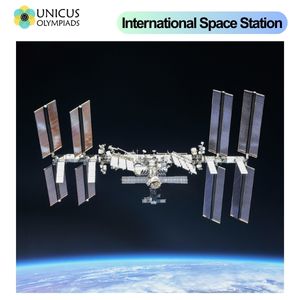

The International Space Station (ISS) is one of the most significant achievements in human space exploration, serving as a collaborative platform for scientific research, technology development, and international cooperation. Orbiting Earth at an altitude of approximately 400 kilometers (250 miles), the ISS is a microgravity laboratory where scientific experiments are conducted in various fields, including biology, physics, astronomy, and Earth sciences. The ISS is also a testament to the power of international collaboration in space exploration, as it is a joint project involving space agencies from multiple countries. This article provides an in-depth look at the ISS, its history, its scientific goals, and the countries that contribute to its operations and maintenance.

The idea of a space station orbiting Earth has been a long-standing dream of scientists and engineers, but the ISS as we know it today was the result of decades of planning, development, and international cooperation. The space station program was initiated in the 1980s, following the success of space stations like the Soviet Union's Salyut and Mir and the United States' Skylab.
The ISS began as separate space station projects by the United States and the Soviet Union. In the 1980s, the United States' plans for a space station, known as Freedom, began to take shape, while the Soviet Union was working on its own space station, Mir-2. However, in the early 1990s, after the end of the Cold War, both nations saw an opportunity to cooperate and merge their efforts into one international project. In 1998, the first module of the ISS, Zarya (a Russian module), was launched into orbit, marking the official beginning of the ISS program.
The ISS serves as an orbiting laboratory where researchers can conduct experiments in a microgravity environment, which is not possible on Earth. This unique environment allows for research in fields such as biology, materials science, physics, and Earth observation. The ISS also serves as a platform for testing technologies that will be needed for future deep-space missions, such as those to Mars.
The primary purpose of the ISS is to conduct scientific research in a variety of fields. Some of the key areas of study include:
In addition to its role in scientific research, the ISS serves as a testbed for technologies that will be used in future space exploration missions. For example, NASA uses the ISS to test life support systems, propulsion technologies, and radiation shielding that will be crucial for missions to the Moon, Mars, and beyond.
The ISS is a multinational project involving cooperation between space agencies from several countries. The five main partners in the ISS program are NASA (United States), Roscosmos (Russia), ESA (European Space Agency), JAXA (Japan Aerospace Exploration Agency), and CSA (Canadian Space Agency). These countries contribute to the operation, research, and maintenance of the space station. Additionally, many other countries contribute to specific research projects or send astronauts to the ISS on a regular basis.
The United States, through NASA, is the lead partner in the ISS program. NASA is responsible for providing key components of the space station, including the Destiny Laboratory and the Harmony node. NASA also manages the operational aspects of the ISS, including the crew rotations and the scientific research conducted aboard the station.
Russia, through Roscosmos, is another key partner in the ISS program. Russia provides several important modules, such as the Zarya and Zvezda modules, and is responsible for the Soyuz spacecraft, which is used to transport astronauts to and from the ISS. Russia also contributes to scientific research and crew operations aboard the station.
ESA is a key partner in the ISS, contributing both technology and research. ESA has provided the Columbus Laboratory module, which is used for conducting scientific experiments. ESA astronauts regularly participate in missions aboard the ISS, and the agency also contributes to international collaboration in space research.
JAXA’s contribution to the ISS program includes the Kibo Laboratory module, which is used for scientific research in the areas of biology, physics, and materials science. Japan is also responsible for launching key components of the ISS and regularly sends astronauts to the station.
Canada's contribution to the ISS includes the robotic arm known as Canadarm2, which is used to move cargo, assist with spacewalks, and perform maintenance tasks on the station. Canada also provides astronaut expertise and contributes to scientific research on board the ISS.
The ISS is a shining example of international collaboration. The station’s design and operation involve the collective efforts of multiple countries, each bringing its own expertise and technological innovations. This collaboration has not only advanced space exploration but also fostered cooperation and diplomacy between nations, particularly during periods of geopolitical tension.
One of the most significant aspects of the ISS is its emphasis on joint missions and shared research. Astronauts from different countries live and work together aboard the station, conducting experiments that benefit all of humanity. This collaborative spirit has made the ISS a model for international cooperation in space.
The ISS has been a remarkable success in advancing space science and fostering international cooperation, but its future is uncertain. The space station was initially envisioned to operate for around 15 years, but it has now been extended through at least 2030. There are discussions about transitioning the station to commercial entities or building new space habitats beyond low-Earth orbit.
As NASA shifts its focus toward returning humans to the Moon and eventually sending astronauts to Mars, the future of the ISS may include a transition to commercial space stations. Companies like SpaceX, Blue Origin, and others are developing their own plans for space stations, which could serve as replacements or partners to the ISS in the coming decades.
International collaboration in space exploration is likely to continue growing, with countries like India (through ISRO) and the United Arab Emirates (UAE) showing interest in contributing to future space missions. The development of new space infrastructure, such as the Lunar Gateway, could further extend the legacy of the ISS into deep space exploration.